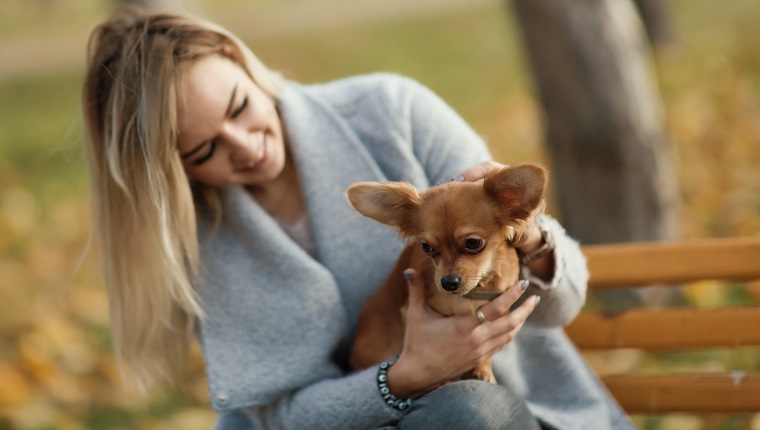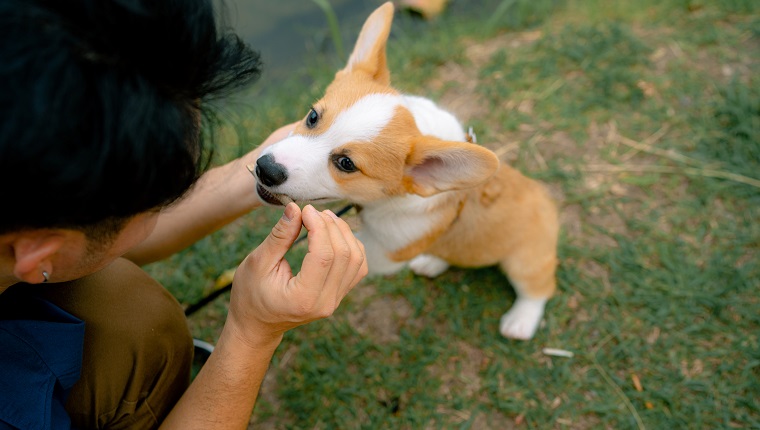One of the great benefits of volunteering at a shelter like Animal Haven in NYC is having the opportunity to foster young puppies and play a part in their development.
I fostered an eight-week-old Chihuahua mix puppy named Edna. To look at her was to love her. She weighed all of two pounds, was a beautiful shade of light cream, and had adorable ears that folded over at the tip.
It is no surprise that it was tempting to scoop Edna up, snuggle her into your arms, and give her a heaping dose of kisses.
Unfortunately, doing so would likely result in a chirping growl and bared teeth. These responses at once seemed funny — who would have thought such a tiny creature could look and sound so menacing? — and on the other hand extremely disconcerting.
To say that Edna had handling issues is putting it mildly.
Letting Aggression Go Sets Dogs Up For Failure
Edna’s diminutive stature and adorableness made her highly adoptable, especially in NYC where people often prefer smaller dogs. But as it stood, she was also highly likely to be returned to the shelter in a few months time.
Even people with the best of intentions may not prepare for the shock of a baby animal they adore and want to shower with human expressions of love responding with growls, snarls, and snaps.
We may somewhat tolerate this behavior during puppyhood. But once the dog reaches adolescence or adulthood, the canine/human relationship will surely head into rapid decline as the dog becomes increasingly menacing.
Edna was on the fast track to becoming just such a dog. So, she became a temporary family member in order to help her develop a better emotional response to people.
The Most Important Thing For Puppies: Socialization

The first four months of a pup’s life play a critical role in how they perceive and respond to future experiences.
We often refer to this as the Critical Socialization Period. But, I also like to call it the Critical Canine Life Skills Period.
Intolerance of human touch not only makes veterinary exams and grooming visits traumatic for all. It makes daily life a sort of mine field.
People must pause to consider the ramifications of putting on the dog’s leash, picking them up to move from one spot to another, and even touching just for the fun of it.
We can say a lot about how it’s better to give than to receive. But when the giving of affection meets an aggressive response, it’s about as gratifying as a trip to the dentist. No offense to any dentists.
While most pet parents would probably rank housetraining as their highest priority, in fact, this top spot should be given to socialization and habituation, particularly to the area of handling and gentling exercises that set the foundation for what a pup feels about human touch.
So, for the next few weeks, Edna and I worked together to make this part of her future something she enjoys. Doing so would set the foundation for her adoption success, as the goal of every shelter is to find each dog a forever home.
An initial surrender to a shelter is bad enough. But a second go around dramatically decreases the odds of a dog ever finding a permanent, loving home. And that’s a fate that should be avoided at all costs for every dog.
Start Handling Early With ‘Learn To Earn’
Whether you have a puppy who is sounding the handling issue alarm loud and clear, like Edna, or who is seemingly mild mannered and accepting of all things human, the handling games should begin as soon as the pup enters your home.
Behavior is a constantly changing thing, especially during critical developmental periods such as from puppyhood to adolescence. So, even the most mild-mannered pup may begin to be less tolerant of handling without an adequate education in this area of their necessary life skills.
To begin, I planned for Edna to go on a puppy-sized version of the Learn to Earn program. I’d need to use each and every thing she wanted as leverage to improve her acceptance of handling.
While some might worry that we shouldn’t expect a dog, especially a young pup, to do much, if anything, to get the things they want and need, this is a mindset that is to the detriment of their long-term survival
The Learn to Earn program is not about withholding things from your dog. Rather, it’s about controlling their access to valued resources, such as food, water, toys, and access to the environment, to use as leverage to help them learn.
Gently touching a pup’s ear just prior to giving them a bit of their meal, or gently manipulating their paws as they play with a favored chew toy is what this program is about.
As the pup makes advances in their manners skills, i.e. sitting, lying down, and hand targeting on cue, you can incorporate them into the list of ways a pup can say ‘please’ in order to have access to what they want.
All pups deserve an approach that is gradual in nature, but especially for a pup such as Edna who was ringing a loud and clear alarm bell that she considered human touch a far from pleasant experience.
Top Tips To Start Handling Practice

To begin, focus on areas of handling that are least likely to evoke a negative response. For most pups the least sensitive areas are flank and chest. The most sensitive are ears, neck, and paws.
Here are some tips for the beginning stages of a handling and gentling plan:
- Start at meal times so food has greater leverage.
- Use your dog’s normal meal and some high value food rewards chopped into tiny pieces. You can use these as ‘jackpot’ rewards for especially calm responses to human touch. You can also use a bone or toy stuffed with moist food to allow your dog to lick from.
- Set your pup up in a comfortable spot. Some good options include sitting on the floor with a dog bed or folded towel.
- Start by gently touching one part of your puppy’s body while you offer a tiny treat or let them lick from a food stuffed toy.
- Provide plenty of repetitions in three to five minute sessions throughout the day.
- Begin practicing with potentially more sensitive areas such as head, paws, and tail once your pup is calmly accepting being touched elsewhere.
- Gradually introduce a very brief pause in between the touch and the offering of the food or food stuffed toy. That way, your pup begins to anticipate a touch means something they value is forthcoming.
By feeding your dog while they are being handled in this gentle manner, you are building a strong association between physical contact and food. Focus on these beginning steps until your pup is looking to you with calm anticipation for the next touch.
At this point you can progress to more advanced handling exercises.
Have you helped a nervous puppy get more comfortable with handling? How did you practice with them? Let us know in the comments below!
Andrea Arden is an animal behavior counselor, rescuer, author, speaker, and pet expert. For more information, check out her website, AndreaArden.com.









